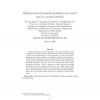Free Online Productivity Tools
i2Speak
i2Symbol
i2OCR
iTex2Img
iWeb2Print
iWeb2Shot
i2Type
iPdf2Split
iPdf2Merge
i2Bopomofo
i2Arabic
i2Style
i2Image
i2PDF
iLatex2Rtf
Sci2ools
NN
2006
Springer
2006
Springer
Rapid decision threshold modulation by reward rate in a neural network
Optimal performance in two-alternative, free response decision making tasks can be achieved by the drift-diffusion model of decision making - which can be implemented in a neural network - as long as the threshold parameter of that model can be adapted to different task conditions. Evidence exists that people seek to maximize reward in such tasks by modulating response thresholds. However, few models have been proposed for threshold adaptation, and none have been implemented using neurally plausible mechanisms. Here we propose a neural network that adapts thresholds in order to maximize reward rate. The model makes predictions regarding optimal performance and provides a benchmark against which actual performance can be compared, as well as testable predictions about the way in which reward rate may be encoded by neural mechanisms.
| Added | 14 Dec 2010 |
| Updated | 14 Dec 2010 |
| Type | Journal |
| Year | 2006 |
| Where | NN |
| Authors | Patrick Simen, Jonathan D. Cohen, Philip Holmes |
Comments (0)

